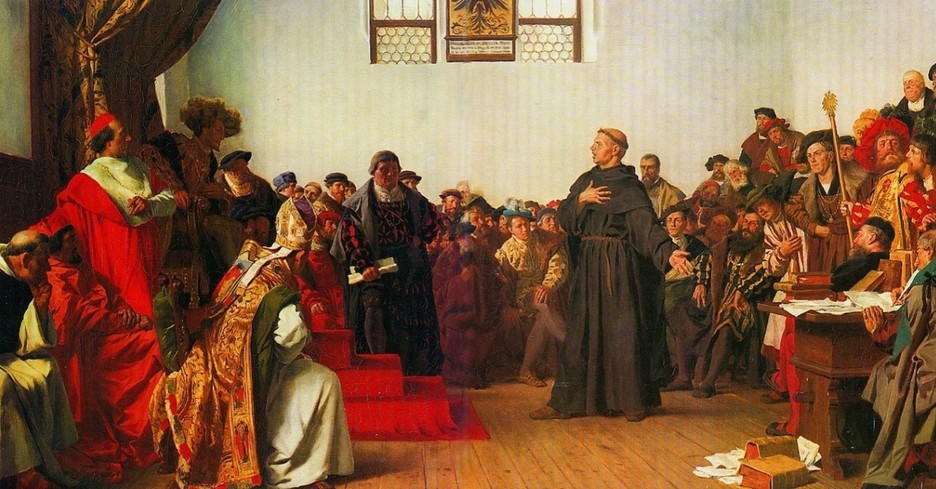
Throughout history, Christians have gathered to consider biblical doctrine and how to return to its ideas. In the sixteenth century, a momentous gathering called the Diet of Worms centered around Martin Luther, a German priest whose beliefs got him in trouble with the Roman Catholic church.
What Was the Diet of Worms?
“Diet” is another term for a council or a “purposeful meeting” meant to deliberate and resolve state or church matters. The Holy Roman Empire, starting with Charlemagne in the early medieval century, used the Imperial Diet to govern all its laws.
Since the Holy Roman Empire began with the Pope crowning Charlemagne in 800 AD, its emperor had a stake in critiques against the Roman Catholic Church. The reigning emperor, Charles V, assembled the Diet of Worms in 1521 to debate and assess Luther’s assertions against the church, made public when Luther attached his 95 theses to the door of the Castle Church in Wittenberg, Germany. The theses were theological complaints and assertions that the church had abused its power.
What Events Led Up to the Diet of Worms?
Roman Catholicism began in the first century. As Barton Gingerich explains, “After Christianity was legalized and the Church continued to fight heresies in various councils and synods, the Pope and his emissaries weighed in on very important doctrinal issues.” To the Roman Catholic church, the Pope’s rulings are tantamount to Scripture. Critics like Luther worried that Roman Catholic tradition had usurped Scripture’s authority.
European biblical literacy spread mainly through the invention of the printing press by Johann Gutenberg in the mid-fifteenth century. The first printing of the Bible sold out, and mass production made the Scriptures available to all people, not just the Roman Catholic clergy.
Roman Catholic leaders were not pleased, saying the Bible belonged in the hands only of their priests and not the laity. Several church councils (such as the Council of Toulouse in 1229 AD and the Ecumenical Council of Constance in 1415 AD) affirmed this stance. In 1536, William Tyndale was burned at the stake for translating the Bible into English).
As more people gained access to the Bible, more people rose to critique Roman Catholic traditions. A tipping point arrived when Luther, Tyndale, and others like John Wycliffe and Jan Hus, criticized sacerdotalism, an ideology stating salvation is not through Christ alone but achieved through the acts and officers of the church (chiefly through dispensing the sacraments). These reformers argued that sacerdotalism teaches works-based salvation, but they weren’t primarily interested in revolving. They were interested in calling people back to the Christian faith’s foundation. However, their efforts were not accepted, and the pope deemed them heretics. Men like Hus started the fire, and Luther added fuel to raise and spread the Reformation.
Who Was Martin Luther Before the Diet of Worms?
We must look at Martin Luther’s life to understand the events that led to the Diet of Worms. Born in 1483 to a prominent foundry owner and his wife, Martin’s father invested heavily in his education. He wished his son to become a lawyer, a vocation Martin proved brilliant at. Until 1505. At age 22, while walking home from university, a lightning bolt from a thunderstorm hit the ground near Luther and knocked him to the ground. He prayed to St. Anne (the patron saint of miners), “Help me, St. Anne; I will become a monk.” He then moved to a monastery founded by Augustine of Hippo—one with demanding daily requirements. This vocational change infuriated Martin’s father, but young Luther stayed the course and vowed to become the best monk ever. He applied his genius for the law to the Bible and knew he fell short of Christ’s commandment in Luke 10:27, to love the Lord with all he was. Guilt racked him.
In 1510, Luther traveled on foot to Rome with another brother from the monastery to present its corporate concerns. The corruption in Rome (promiscuous priests, holy ordinances handled casually) rattled him. However, he looked forward to visiting the Lateran church, where the Crusaders had installed the steps Jesus had reportedly used to ascend to Pilate. Luther’s pilgrimage included crawling up them a step at a time, repeating a “Hail Mary” or “Our Father,” then purchasing an indulgence (acts of service or donations to the church to secure less time in Purgatory) after reaching the top. Except, when Martin reached the pinnacle, he said, “Who knows if it is true?”
In 1513, Frederick, Elector of Saxony, requested that Luther and three other esteemed scholars be sent to the newly established Wittenberg University. Luther was selected to be a professor of the Bible. As a professor, Luther propelled his Bible study method of finding each passage’s literal sense according to how the Bible was written—as opposed to the quadriga method, which Luther said was like a nose of wax that could be twisted into whatever shape one desired.
Luther’s famous tower experience came when he studied Romans to prepare for teaching it. As he studied, Romans 1:17 brought him nose-to-nose with the meaning of the original Greek—God’s grace. Luther said that when he discovered this grace, he was born again, and for the first time in his life, he understood the Gospel.
At the time, papal corruption was rampant. Indulgences were sold throughout the Holy Roman Empire to raise money for building projects (like St. Peter’s in Rome) and satisfy church leaders’ greed. Some people became specialists in manipulating audiences to buy indulgences. Dominican monk
Johann Tetzel, a Dominican monk, oversaw indulgence sales in parts of Germany, including near Wittenburg. He coined the phrase, “Every time a coin in the coffer rings, a soul from purgatory springs.” Luther’s ire at the corruption prompted him to write his ninety-five theses and post them on the door of Wittenburg’s Castle Church, essentially a community bulletin board.
Luther did not plan nor intend for the theses to receive wide distribution. He wrote them in Latin so the university professors could debate his points. None responded. However, almost immediately, Latin-reading students translated Luther’s documents into German and made copies. Thanks to the printing press, thousands of copies spread throughout the country.
What Happened Between the Ninety-Five Theses and the Diet of Worms?
Luther maintained his obligation to the Roman Catholic church and wrote a less inflammatory document that made its way to Rome, and the papacy had a new “whipping boy.” Luther’s protestation interfered with the plans to fund St. Peter’s in Rome. More significantly, he opened people’s eyes to what was truly occurring.
In 1518, Rome sent Cardinal Cajetan to Augsburg to try Luther for heresy. Luther was eager to debate. After four discouraging dialogues, Cajetan insisted that Luther recant and promise never to teach his beliefs again. The cardinal focused on indulgences and the treasury of merits—traditions of the Catholic church—while Luther stood his ground on biblical truth. Cajetan became so enraged Luther barely escaped back to Wittenberg.
1519 brought the Disputation in Leipzig with the chief German Roman Catholic theologian Johann Eck. Eck skillfully wound his argument to the conclusion Luther’s teachings were similar to Jan Hus (who the Catholics burned to death one hundred years before).
In 1520, Pope Leo X issued a papal bull (an edict used to communicate something to the church) that condemned Luther as a heretic and ordered that his writings be publicly burned in St. Peter’s Square in Rome. When the bull arrived in Wittenberg, Luther burned it in his own bonfire.
Emperor Charles convened the Imperial Diet in Worms, Germany, to quell the uprising Luther had created. Charles invited Luther, promising safe passage. Luther still planned to stand and reason with the pope’s representatives, assured of his belief in salvation by faith alone. When he arrived, peasant supporters lined the streets, which alarmed the authorities.
Luther’s writings were atop a table in the middle of the grand hall. When asked if they were indeed his, Luther replied in the affirmative. No debate ensued. Instead, Luther was soundly ordered to recant (to say revoco). Luther asked where the heresies in his writings were. Once again, he was ordered to recant. Luther asked for a 24-hour hour respite. After a night of prayer, he entered the hall and said (in part), “Unless I’m convinced by sacred Scripture or by evident reason, I cannot recant, for my conscience is held captive by the Word of God, and to act against conscience is neither right nor safe. Here I stand. I can do no other. God help me.”
What Was the Result of the Diet of Worms?
Many changes came from the Diet of Worms, but these four are worth noting.
1. Luther and other reformers, like John Calvin, brought about the Protestant Reformation, changing the face of Christianity.
2. The Roman Catholic church held the Council of Trent (1545-1563) to refute and condemn the Protestants. This council began the Counter-Reformation.
3. The Apocrypha, a collection of deuterocanonical books the Roman Catholic church accepted as Scripture, were rejected by Protestants.
4. Scripture alone (Sola Scriptura) and justification by faith alone became the norm for Christian obedience and life.
Luther had no intention of starting a revolution. He sought a civilized debate, but God used his words to help focus the Christian church on what it should be: wholly based on God’s Word. Sin still abounds within the church—nothing will remove sin but glorification. But when the truths of Scripture are revealed to more and more people, the church grows, and God gets the glory. God used the Reformation in part to point people to His Word.
How Did Martin Luther’s Work Change After the Diet of Worms?
When Luther refused to recant, those assembled flew into a rage of confusion. The pope excommunicated Luther after the Diet of Worms. Charles V put a price on his head, and Luther was given 21 days of protection to Wittenberg before the sentence was executed. Luther’s friends faked a kidnapping and stole Luther away to the Wartburg castle, where he disguised himself as a knight for a year. He used the time to write a German translation of the New Testament.
Luther married Katherine von Bora, a former nun, in 1525, and they had six children. He stayed primarily in Wittenburg for the rest of his life, preaching, lecturing, writing, and debating. He fell prone to illness in his later years yet enjoyed a happy life with his family. He died in 1546 and was buried in front of the Castle Church.
Photo Credit: 19877 Anton von Werner painting of the Diet of Worms. Public domain, via Wikimedia Commons.

_639003522088907085.jpg)

